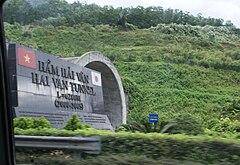Hải Vân Tunnel: Difference between revisions
m Colonies Chris moved page Hai Van Tunnel to Hải Vân Tunnel: sp |
minor fixes |
||
| Line 1: | Line 1: | ||
[[File:Hai Van Tunnel Entrance.JPG|thumb|240px|The southern end of the |
[[File:Hai Van Tunnel Entrance.JPG|thumb|240px|The southern end of the Hải Vân Tunnel]] |
||
The ''' |
The '''Hải Vân Tunnel''', the longest tunnel in Southeast Asia at 6.28km, lies on highway 1 between the two cities of [[Da Nang]] and [[Huế]] in central [[Vietnam]]. |
||
==History== |
==History== |
||
The [[ |
The [[Hải Vân Pass]] has long been recognised as a major bottleneck. The concept of a tunnel to bypass the long route over the top had long been sought. |
||
==Planning and |
==Planning and design== |
||
Route planning and design work started in January 1998 by a joint venture between Nippon Koei Company Limited Japan and Louis Berger |
Route planning and design work started in January 1998 by a joint venture between Nippon Koei Company Limited Japan and Louis Berger Internationa] Inc., USA with the Vietnamese Transport Engineering Design Incorporated (TEDI) providing consultation on the project. |
||
<!-- Image with unknown copyright status removed: [[Image:haivangroup.jpg|small|right]] [[Image:HaiVan3.gif|small|right|200px|Drawing of the tunnel construction]] --> |
<!-- Image with unknown copyright status removed: [[Image:haivangroup.jpg|small|right]] [[Image:HaiVan3.gif|small|right|200px|Drawing of the tunnel construction]] --> |
||
==Construction== |
==Construction== |
||
[[File:Hai Van Tunnel North Face.JPG|thumb|240px|The north end of the |
[[File:Hai Van Tunnel North Face.JPG|thumb|240px|The north end of the Hải Vân Tunnel. The second maintenance tunnel is at left.]] |
||
The project's major constructors were a |
The project's major constructors were a Vietnam–Japan joint venture, Hazama-Cienco 6, and a joint venture between Korea's Dong Ah construction company and Vietnam's Song Da Construction Corporation. |
||
The tunnel officially opened on June 5, 2005. |
The tunnel officially opened on June 5, 2005. |
||
| Line 24: | Line 24: | ||
A small waiting area has been established at each end of the tunnel where visitors can take photographs and watch a documentary about the making of the tunnel. |
A small waiting area has been established at each end of the tunnel where visitors can take photographs and watch a documentary about the making of the tunnel. |
||
The tunnel reduces the distance between [[Da Nang]] and [[Huế]] by 20km and saves between 30 minutes and an hour on traveling times over the old |
The tunnel reduces the distance between [[Da Nang]] and [[Huế]] by 20km and saves between 30 minutes and an hour on traveling times over the old Hải Vân Pass route. |
||
==References== |
==References== |
||
Revision as of 12:38, 7 August 2013

The Hải Vân Tunnel, the longest tunnel in Southeast Asia at 6.28km, lies on highway 1 between the two cities of Da Nang and Huế in central Vietnam.
History
The Hải Vân Pass has long been recognised as a major bottleneck. The concept of a tunnel to bypass the long route over the top had long been sought.
Planning and design
Route planning and design work started in January 1998 by a joint venture between Nippon Koei Company Limited Japan and Louis Berger Internationa] Inc., USA with the Vietnamese Transport Engineering Design Incorporated (TEDI) providing consultation on the project.
Construction

The project's major constructors were a Vietnam–Japan joint venture, Hazama-Cienco 6, and a joint venture between Korea's Dong Ah construction company and Vietnam's Song Da Construction Corporation.
The tunnel officially opened on June 5, 2005.
The main tunnel is 11.9 meters wide. A second tunnel running alongside the main tunnel is currently used for maintenance and emergencies but it is planned to expand this at a later date as traffic increases. It is connected to the main tunnel by 15 cross-tunnels. The tunnels have lighting, fire alarms, communication, water supply and treatment, ventilation fans, and radio broadcast systems.
The tunnel subsequently has received an award for quality by the American Construction Management Association. [1]
Operation
Currently the single tunnel has one lane of traffic in each direction. As no overtaking is possible this can result in minor delays if you are stuck behind slow moving traffic. A toll of VND25,000 is payable for cars/mini buses.
Motorcycles, cycles and pedestrians are not allowed in the tunnel but a new shuttle service began in November 2006. This shuttle service operates around the clock with a reduced overnight service and a daytime fare of VND12,000 per motorcycle, VND5,000 per bicycle, and VND3,000 per person.
A small waiting area has been established at each end of the tunnel where visitors can take photographs and watch a documentary about the making of the tunnel.
The tunnel reduces the distance between Da Nang and Huế by 20km and saves between 30 minutes and an hour on traveling times over the old Hải Vân Pass route.
